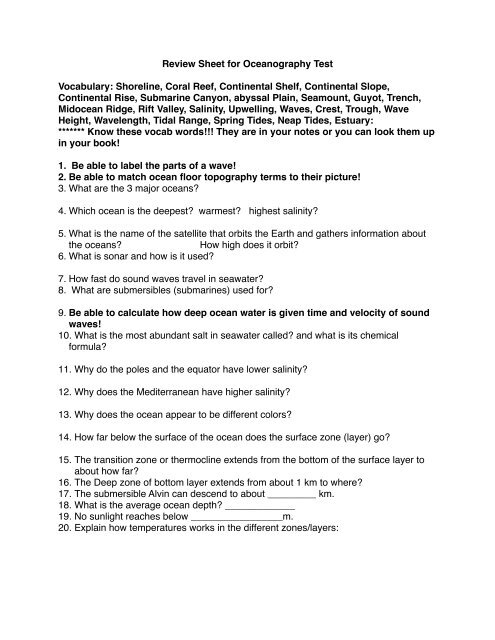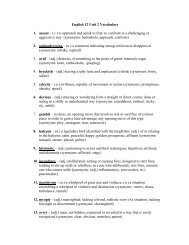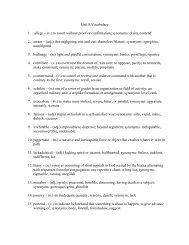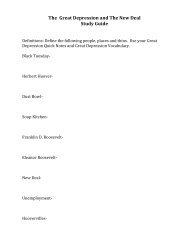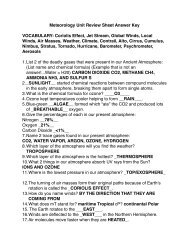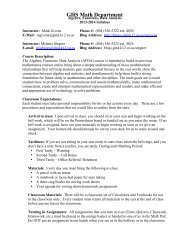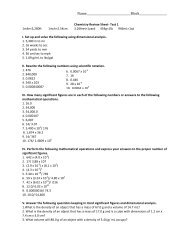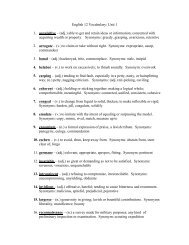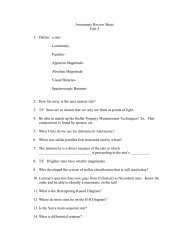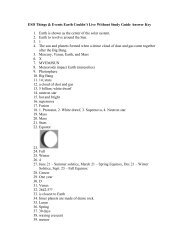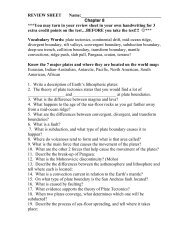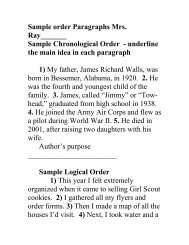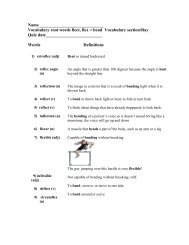Review Sheet for Oceanography Test
Review Sheet for Oceanography Test
Review Sheet for Oceanography Test
Create successful ePaper yourself
Turn your PDF publications into a flip-book with our unique Google optimized e-Paper software.
<strong>Review</strong> <strong>Sheet</strong> <strong>for</strong> <strong>Oceanography</strong> <strong>Test</strong>Vocabulary: Shoreline, Coral Reef, Continental Shelf, Continental Slope,Continental Rise, Submarine Canyon, abyssal Plain, Seamount, Guyot, Trench,Midocean Ridge, Rift Valley, Salinity, Upwelling, Waves, Crest, Trough, WaveHeight, Wavelength, Tidal Range, Spring Tides, Neap Tides, Estuary:******* Know these vocab words!!! They are in your notes or you can look them upin your book!1. Be able to label the parts of a wave!2. Be able to match ocean floor topography terms to their picture!3. What are the 3 major oceans?4. Which ocean is the deepest? warmest? highest salinity?5. What is the name of the satellite that orbits the Earth and gathers in<strong>for</strong>mation aboutthe oceans?How high does it orbit?6. What is sonar and how is it used?7. How fast do sound waves travel in seawater?8. What are submersibles (submarines) used <strong>for</strong>?9. Be able to calculate how deep ocean water is given time and velocity of soundwaves!10. What is the most abundant salt in seawater called? and what is its chemical<strong>for</strong>mula?11. Why do the poles and the equator have lower salinity?12. Why does the Mediterranean have higher salinity?13. Why does the ocean appear to be different colors?14. How far below the surface of the ocean does the surface zone (layer) go?15. The transition zone or thermocline extends from the bottom of the surface layer toabout how far?16. The Deep zone of bottom layer extends from about 1 km to where?17. The submersible Alvin can descend to about _________ km.18. What is the average ocean depth? _____________19. No sunlight reaches below _________________m.20. Explain how temperatures works in the different zones/layers:
21. Explain how salinity works in the different zones/layers:22. Pressure goes __________ the further you go ___________ into the ocean.23. Pressure goes up at the rate of 150 pounds per ______________ of depth.24. What are the 4 components of a climate system?25. Ocean surface circulation depends on what factor?26. Why is ocean circulation important? (know all 4 reasons!)27. How fast do surface currents move?28. What current flows by the East Coast of the US?29. What current flows along the bottom of the globe, almost in a straight line?30. Why is upwelling important?31. What happens during an El Nino event?32. What drives Earth’s weather?33. What causes waves? (know all 3)34. When does a wave go from only moving up and down to moving <strong>for</strong>ward andbackward as well?35. What is the <strong>for</strong>ce behind wind causing waves?36. What is a tide?37. How long does it take <strong>for</strong> 1 high tide/low tide cycle?38. What body in our solar system has the most effect on tides? Why?39. Because of the gravitational effect of the Moon, where do the 2 big bulges of water<strong>for</strong>m on the Earth?40. How do those bulges move?41. Be able to label pictures of Spring and Neap Tides!42. How do sea levels fall and rise?43. What estuary is located near us and is the largest estuary in the US?44. Algae in oceans is an important source of __________________________.45. Oceans are an important source of ____________ and ________________ and areused <strong>for</strong> ____________________ and ____________________.46. How does pollution harm the ocean?47. How does over-fishing harm the ocean?48. The emission of light by living organisms is called __________________________.49. What is the fishing term used to describe animals that are caught accidentally?


